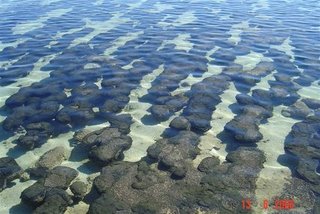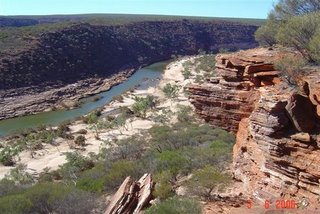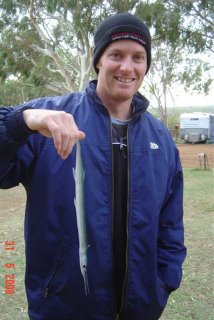That afternoon we rode the “Fruit Loop” taking the northern & southern roads on either side of the mighty Gascoyne River that supplies all the water to Carnarvon and its agricultural industry. You’d never think so to see the vast sandy riverbed as it is predominantly an underground river – only running above ground for 120 days in a year. Massive crop nets creating a different kind of horticultural city and Lea enjoyed taking a ‘sticky beak’ at prices and produce for sale at roadside stalls each with a honesty box.
Sunday took us out to Rocky Pool some 50 kms up the Gascoyne. Here, the river runs over a rocky floor creating a most attractive permanent pool that has become a popular spot for both locals and travellers alike.
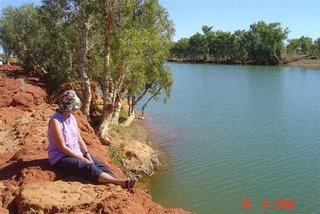 Rocky Pool - Gascoyne River
Rocky Pool - Gascoyne RiverWe walked upstream and at a point needed to wade through one of the riffles in order to get to the opposite bank. Lea, reluctant to remove her shoes & socks begged a piggyback and her husband obliged only to falter midstream when a patch of quicksand had him sink to his knees. With that we both collapsed into the stream. It must have been most amusing for any onlookers! Once on the other side Lea removed her pants to ring them out and left them on a rock to dry while a number of kookaburras began chuckling away in the trees.
On our return home we went in search of the Bibbawarra bore – originally drilled for coal in 1903. It was drilled to a depth of 914m and ever since has been producing a constant flow of hot water measuring 65°C (!), far too hot to touch.
We collected Paula Baxter late Monday night after her long day on a coach from Perth. She now lives in Queensland and has joined us to explore the Outback Coast (stretching from Carnarvon to Exmouth). Probably our most widely travelled adventuring friend - we first met Paula when she was Justine and then Saxon’s Year 4 teacher back in South Africa – Maidstone.
The Blowholes campsite, 50km north of Carnarvon, was full of caravans and people living in a few small corrugated iron shacks, we were actually lucky to find ourselves a site at the far end of the camp ground. Mid afternoon, with the tide high, we walked back towards the blowholes and spent a memorable hour watching the waves crashing against the limestone platforms, the fountains of spray being generated, listening to the roar of the air being compressed in the blowhole and walking in the spray zone.
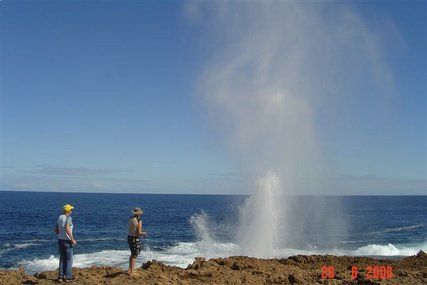 Lea and Paula Baxter at the Blowholes
Lea and Paula Baxter at the BlowholesLea collected a pocket full of crystal salt taken from the depressions in the rocks where the water had evaporated, so now we have the real stuff, direct from the sea, on our food!
Having heard so much about the rough road to Red Bluff (60km further north) we took it mighty slowly and did not find it all that bad. It was heart-warming to roll into this particular place at long last and bring to life all the tales we had heard from Justine & Daniel, Jamie and Emma over the years.
 Red Bluff
Red BluffLater, we walked out to the point of Red Bluff following a path that picked its way through the limestone rocks at the foot of the spinifex covered slopes to make our first pilgrimage to the memory of Jamie. He was very much on our minds as we looked out over the bay, his final resting place – an area ‘our four’ loved so much, even if somewhat more developed now than when they were last here. The sea so calm that the waves creating Red Bluff’s famous “Bluff Barrel” scarcely evident. A stack of surfboards left amongst the rocks, the owners nowhere in sight, an indication of how trusting people are. At low tide we walked in ankle deep water along the limestone platforms that had become exposed, finding them to be full of clams and sea urchins. We even saw Otto and Roo’s Nemo hiding there.
We were, however quite taken aback at the cost of camping at Red Bluff; $10 per head per night – with no facilities other than a pit latrine. Nevertheless it certainly was a “loo with a view” and, if engaged, one had to yell out at any approaching party.
Our next camp was at Three Mile Beach on remote Gnarloo Station – a busy place with mod-cons we never expected to find: Hot salt water showers, flushing toilets and telephones. To the south the famous waves that beckon surfers from all over the world breaking; to the north a shallow lagoon filled with coral and a nice sandy beach.

Nearshore corals in lagoon at Gnarloo
Water warm enough for George to take his first swim in the sea and a low tide inviting enough for Paula to don her goggles and mask and do some snorkelling over the clumps of coral that lay close inshore. Shoals of electric blue fish, striking white and black species, blue-tipped corals – the water crystal clear.
As there are no roads north of Gnarloo we had to return the way we had come and en route spent a night camping in the bush at Bibbawarra bore. A quiet spot tucked away outside Carnarvon but the ground infested with sharp three-pronged thorns (“bindies”) that threatened to cripple us the moment we stepped outside without shoes. With the piping hot water from the bore now running to waste we could not help wondering why some enterprising fellow does not develop a mineral spa resort (like Tshipise) and make a fortune?
So we’ve popped back to Carnarvon for the night. In the morning we’ll send off the blog, refuel and re-supply with fresh bread & milk before setting off for Coral Bay, Exmouth and Ningaloo Marine Park.


